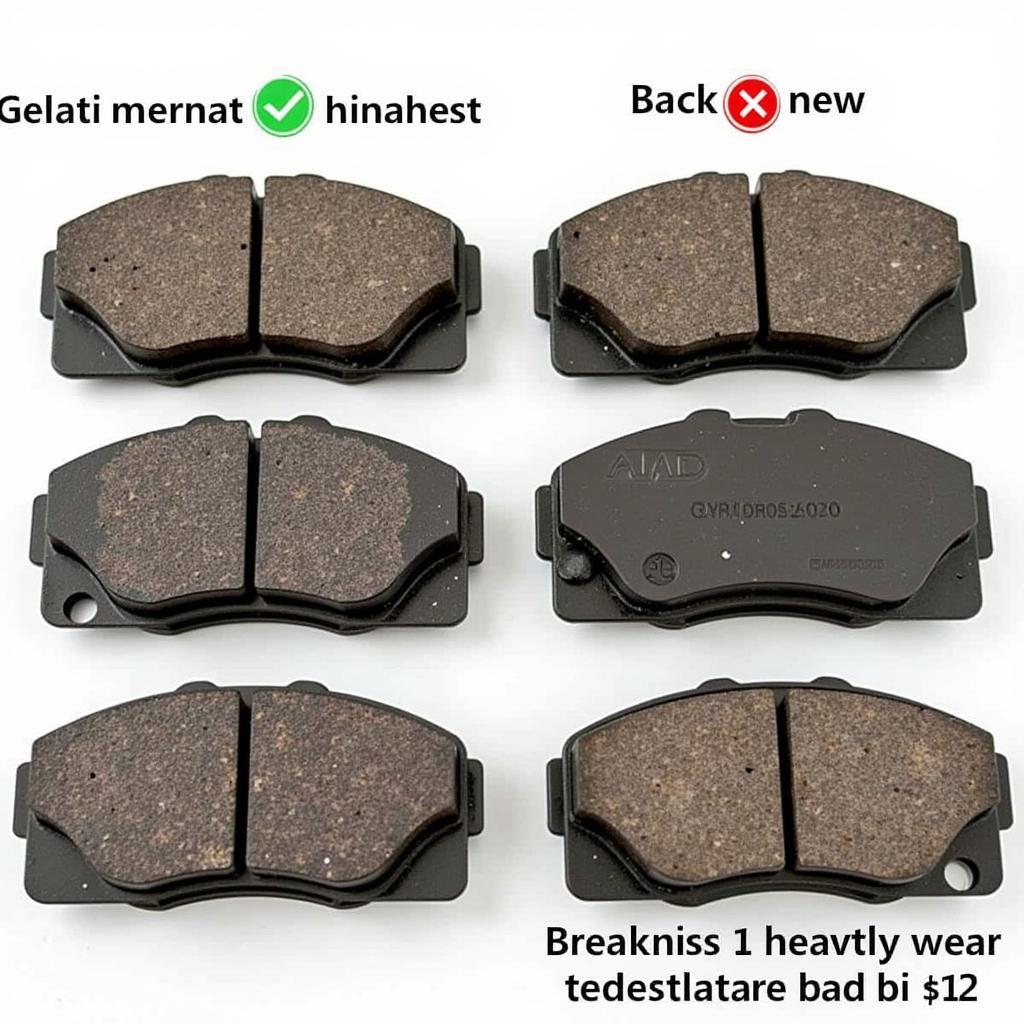The dreaded brake pad wear warning light pops up on your dashboard, and suddenly, you’re a little less excited about that road trip you were planning. Don’t panic! A Mercedes brake pad wear warning doesn’t necessarily mean you have to slam on the brakes and call a tow truck. This article will guide you through understanding what this warning means, why it’s crucial, and what steps you should take.
Understanding Your Mercedes Brake Pad Wear Warning
Your Mercedes-Benz is designed with safety in mind, and that includes a sophisticated system for monitoring your brake pads. When the “brake pad wear” light illuminates, it means your brake pads have worn down to a predetermined level and require attention. But why is this warning so crucial, and what does it tell you?
 Worn Brake Pads vs New Brake Pads
Worn Brake Pads vs New Brake Pads
The Importance of Brake Pads
Brake pads are the unsung heroes of your vehicle’s safety system. They’re the workhorses that clamp down on the brake rotors, generating the friction needed to slow down or stop your Mercedes. Over time, this friction wears down the pads, and neglecting their replacement can have serious consequences.
How the Warning System Works
Mercedes-Benz vehicles typically utilize one of two systems to monitor brake pad wear:
- Wear Sensors: Most models employ small, strategically placed sensors within the brake pad material. As the pad wears down, the sensor eventually contacts the brake rotor, completing a circuit and triggering the warning light on your dashboard.
- Brake Pad Wear Monitoring System: Some newer models feature a more advanced system that electronically monitors pad thickness and alerts you when replacement is necessary.
 Mercedes Brake Pad Wear Sensor
Mercedes Brake Pad Wear Sensor
What to Do When the Warning Light Appears
Ignoring a brake pad wear warning can lead to costly repairs and compromise your safety. Here’s what you should do:
- Assess the Urgency: If you’ve recently had your brake pads inspected or replaced, the warning light might indicate a faulty sensor. However, it’s always best to err on the side of caution.
- Check Your Owner’s Manual: Your Mercedes owner’s manual will provide specific information on interpreting warning lights and recommended service intervals for your model.
- Schedule an Inspection: Contact a qualified mechanic or your Mercedes-Benz dealership to schedule a brake inspection. They can assess the condition of your brake pads, rotors, and other brake components.
- Don’t Delay Replacement: If your brake pads are worn down, don’t postpone replacement. Driving with worn-out brake pads reduces your stopping power and can damage your rotors, leading to more expensive repairs.
Beyond Brake Pads: Other Potential Issues
While the brake pad wear warning usually points to worn-out pads, it’s essential to consider other potential culprits:
- Faulty Brake Pad Wear Sensor: A malfunctioning sensor can trigger a false warning.
- Worn Brake Rotors: Uneven wear or deep grooves on your brake rotors can also impact braking performance and trigger the warning light.
- Brake Fluid Leak: A leak in your brake lines can lead to a loss of brake fluid and trigger the warning light.
A qualified mechanic can diagnose the root cause of the warning light and recommend the appropriate course of action.
Preventing Premature Brake Pad Wear
While brake pad wear is inevitable, you can take steps to prolong their lifespan and ensure optimal braking performance:
- Avoid Aggressive Driving: Hard braking and rapid acceleration put excessive strain on your brakes, leading to faster wear.
- Coast When Possible: Anticipate stops and gradually reduce speed by coasting, rather than relying heavily on your brakes.
- Lighten Your Load: Carrying excessive weight in your vehicle puts additional strain on your braking system.
- Schedule Regular Brake Inspections: Routine brake inspections, as recommended in your owner’s manual, can help identify potential issues early on.
FAQs: Mercedes Brake Pad Wear Warning
Q: Can I drive with the brake pad wear warning light on?
A: While you might be able to drive a short distance, it’s strongly advised against it. Driving with worn brake pads significantly reduces your stopping power and can lead to further damage to your braking system.
mercedes check brake pad wear warning
Q: How much does it cost to replace Mercedes brake pads?
A: The cost of brake pad replacement can vary depending on your Mercedes model, the type of brake pads used, and labor costs in your area.
Q: How often should I replace my Mercedes brake pads?
A: There’s no one-size-fits-all answer, as brake pad lifespan depends on driving habits and conditions. However, it’s generally recommended to have your brake pads inspected every 10,000 to 12,000 miles.
2007 mercedes cls550 brake warning light
Q: Can I replace my Mercedes brake pads myself?
A: While it’s possible, brake pad replacement requires mechanical expertise and specialized tools. It’s generally safer and more efficient to have it done by a qualified mechanic.
Q: What happens if I ignore the brake pad wear warning light?
A: Ignoring the warning can lead to severe consequences, including brake failure, rotor damage, and an increased risk of accidents.
mercedes glk brake pad warning
Keeping Your Mercedes Safe and Reliable
Addressing a Mercedes brake pad wear warning promptly is crucial for your safety and the longevity of your vehicle. By understanding the warning signs, taking preventative measures, and seeking timely professional service, you can ensure that your Mercedes continues to deliver a smooth, safe, and enjoyable driving experience for miles to come.

